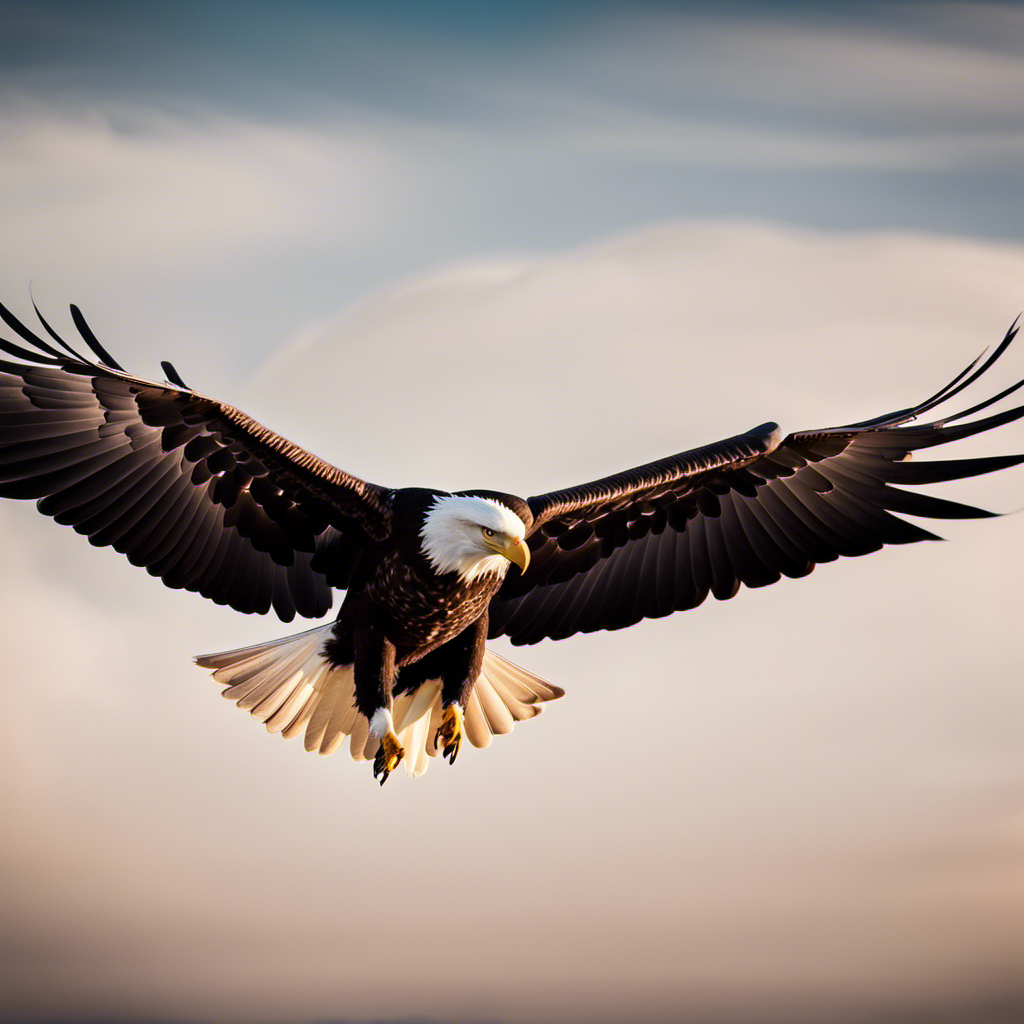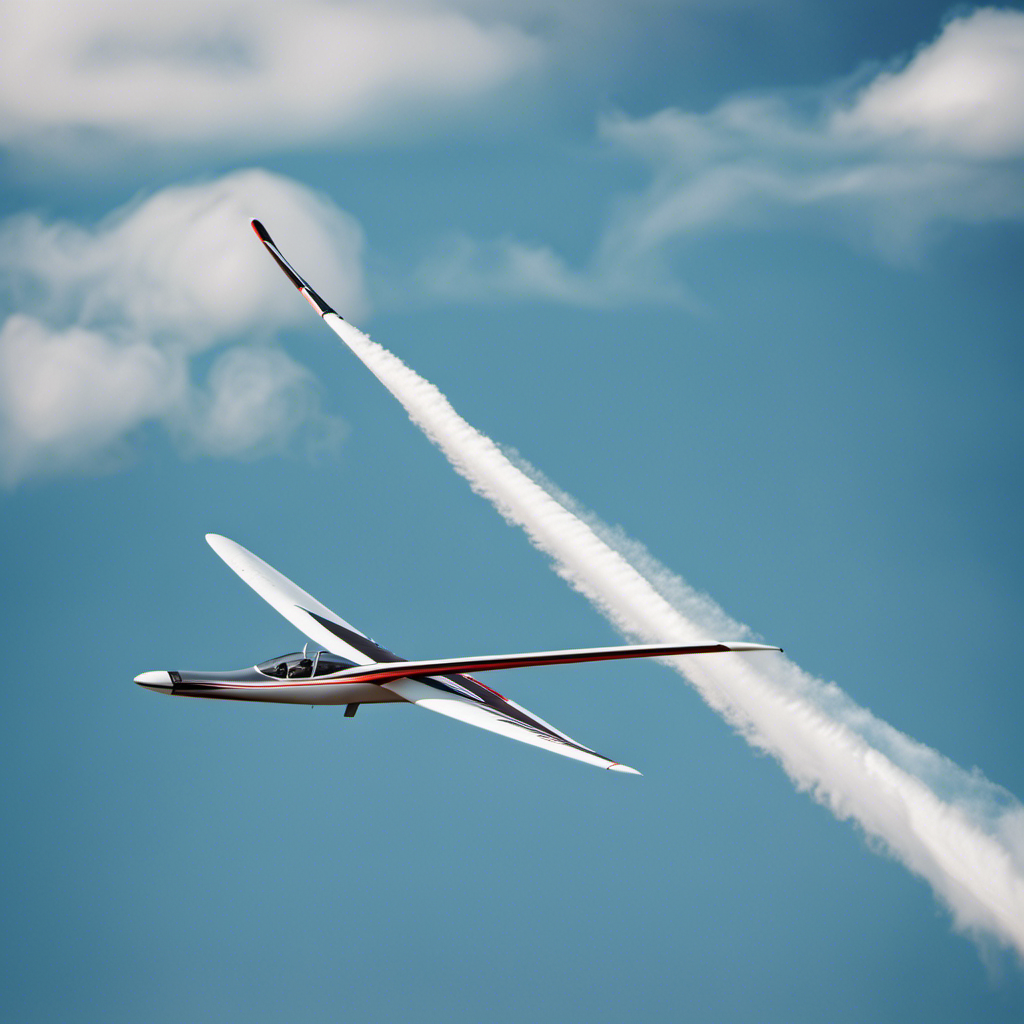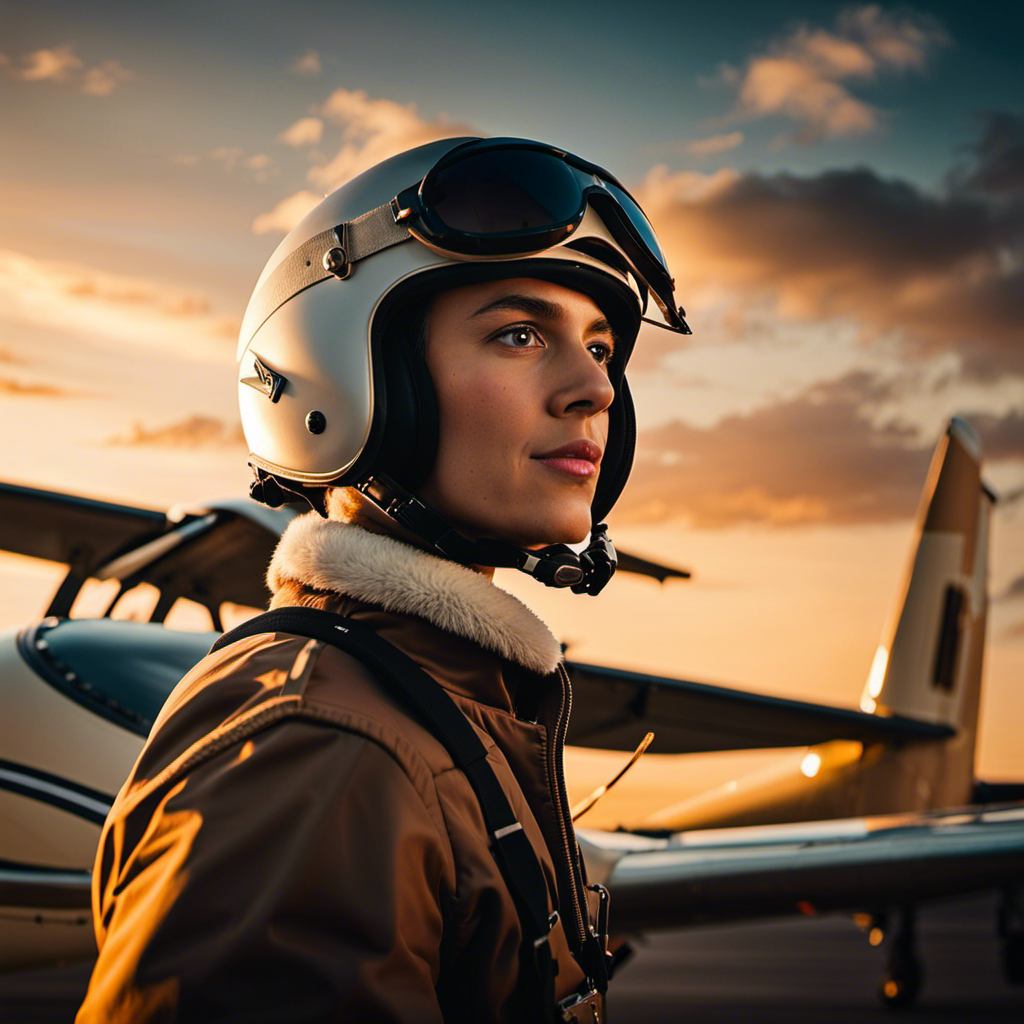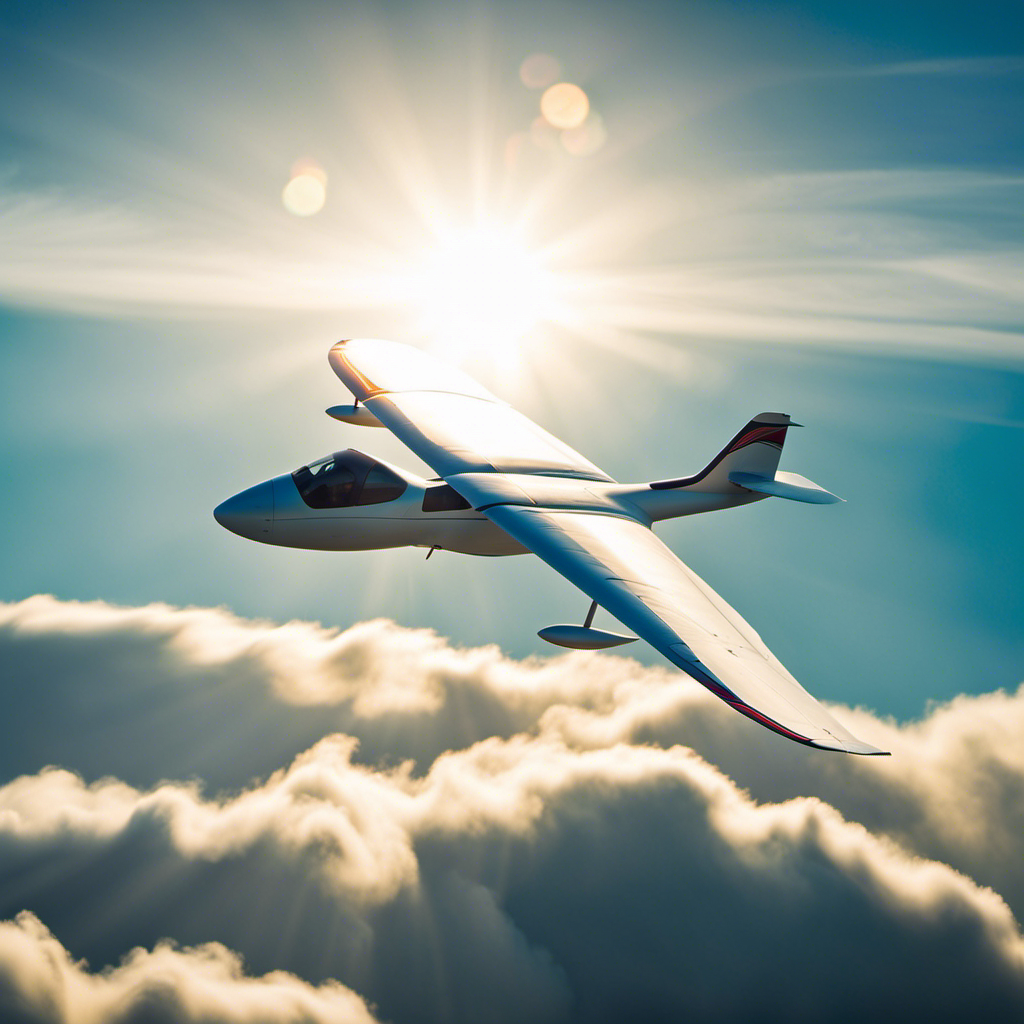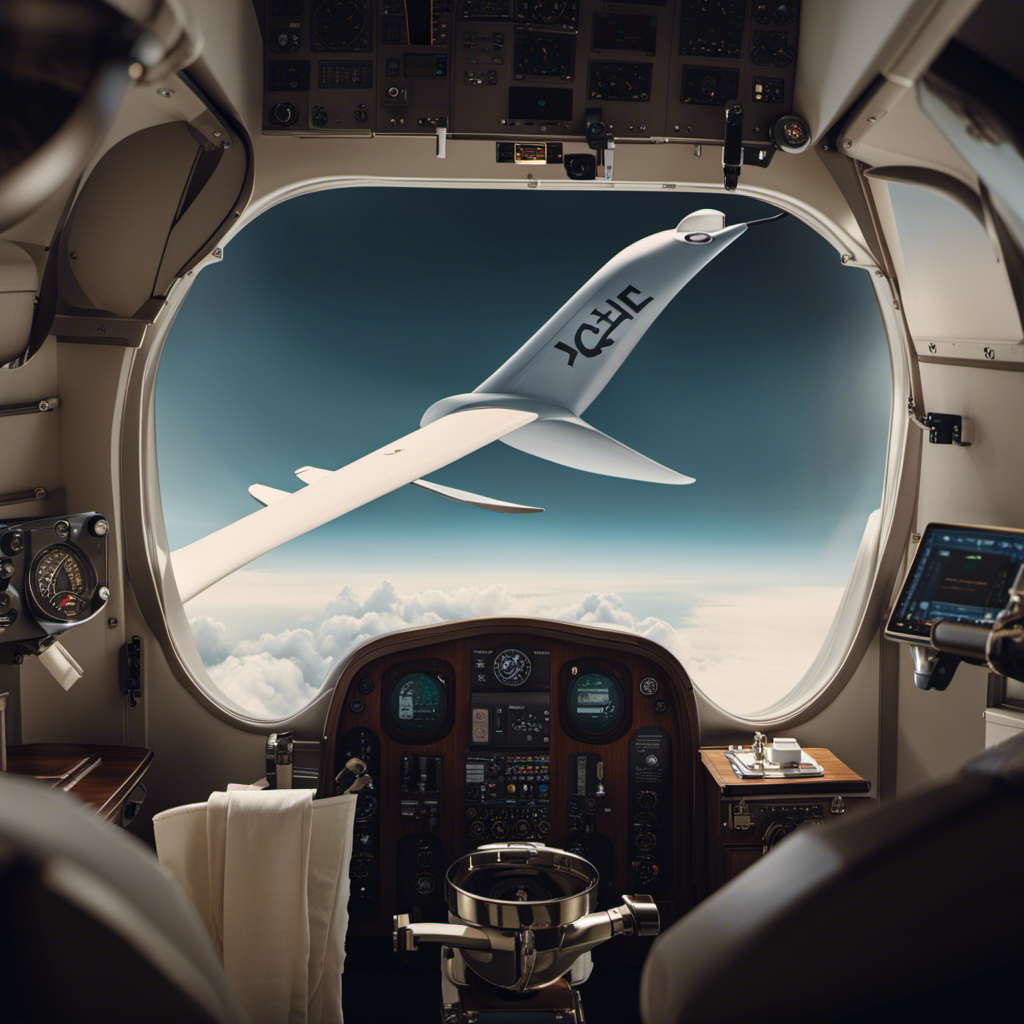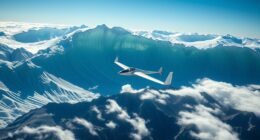As an aviation enthusiast, I often hear the phrase, ‘Soaring is like flying, but without the engine.’ But is soaring truly the same as flying?
In this article, we’ll delve into the mechanics of both activities and explore what sets soaring apart.
From understanding the different types of soaring activities to the benefits and challenges it presents, we’ll also take a look at popular destinations and competitions in the soaring world.
So let’s strap in and soar into the fascinating world of non-powered flight!
Key Takeaways
- Soaring refers to staying aloft without propulsion, utilizing natural sources of lift.
- Soaring requires skillful piloting and understanding of natural sources of lift.
- Soaring relies on natural air currents such as thermals, ridge lift, and wave lift.
- Gliding, hang gliding, and paragliding are popular forms of soaring activities.
Definition of Soaring and Flying
Do you know the difference between soaring and flying? Let me explain the mechanics of flight and the differences between these two terms.
Soaring refers to the act of staying aloft without any propulsion. It relies on the natural sources of lift, such as thermals and updrafts, to maintain altitude and glide through the air. It requires skillful piloting and an understanding of how to exploit these sources of lift effectively.
On the other hand, flying encompasses a broader concept that includes both powered and unpowered flight. It involves utilizing engines or other forms of propulsion to generate thrust and maintain altitude. Understanding the mechanics of flying involves comprehending the principles of aerodynamics, control surfaces, and the interaction between the aircraft and the surrounding air.
Understanding the Mechanics of Flying
Understanding how you can effortlessly glide through the air involves grasping the intricate mechanics of flight. To truly comprehend the mechanics of lift and the principles of aerodynamics, consider the following:
-
The Bernoulli principle: This principle explains how the difference in air pressure creates lift. As air flows over the curved upper surface of a wing, it accelerates, creating lower pressure. This lower pressure lifts the wing.
-
Angle of attack: The angle at which the wing meets the oncoming airflow affects lift. By adjusting the angle of attack, pilots can increase or decrease lift.
-
Wing shape: The shape of the wing is crucial for generating lift. The curved upper surface and flatter lower surface help create the necessary pressure difference to lift the aircraft.
What Sets Soaring Apart from Flying
Utilizing natural air currents is a key factor that sets soaring apart from regular flying. By harnessing the power of updrafts and thermals, gliders are able to achieve sustained flight without the need for an engine.
These air currents, caused by variations in temperature and wind patterns, provide the necessary lift for the glider to stay aloft for extended periods of time.
Understanding and effectively utilizing these natural forces is crucial for successful soaring and is a skill that requires technical knowledge and analytical thinking.
Utilizing Natural Air Currents
Soaring is a technique aviators use to harness natural air currents for lift. Understanding air currents is crucial for successful soaring. Here are three techniques for maximizing lift while soaring:
-
Thermals: These are rising columns of warm air created by the sun heating the Earth’s surface. By circling within a thermal, a pilot can gain altitude and extend their flight time.
-
Ridge Lift: When wind encounters a slope or ridge, it is forced upwards, creating lift. Pilots can fly along the ridge, using the upward air current to stay aloft.
-
Wave Lift: This occurs when wind encounters a mountain range and produces standing waves of air on the leeward side. By riding these waves, pilots can achieve significant altitude gains.
By understanding and utilizing these air currents, aviators can maximize their lift and extend their soaring flights.
Now, let’s transition into the subsequent section about achieving sustained flight without relying on engine power.
Achieving Sustained Flight
In order to achieve sustained flight without relying on engine power, I must master the art of gliding. Understanding lift and harnessing thermals are crucial aspects of this skill.
Lift is the force that counteracts the weight of the aircraft, allowing it to stay aloft. It is generated by the flow of air over the wings, with factors such as wing design and angle of attack affecting its magnitude.
Thermals, on the other hand, are rising columns of warm air that can provide additional lift for gliders. By circling within a thermal, I can gain altitude and prolong my flight. These techniques require precise control and constant adjustments to stay within the rising air currents.
Transitioning into the subsequent section about ‘types of soaring activities’, it is important to explore the various ways in which pilots can engage in this exhilarating form of flight.
Types of Soaring Activities
When it comes to types of soaring activities, three popular options are gliding, hang gliding, and paragliding.
Gliding involves flying a fixed-wing aircraft without an engine, relying solely on natural forces like wind and thermals to stay aloft.
Hang gliding, on the other hand, requires a pilot to be suspended underneath a fabric wing while using their body weight to control the aircraft.
Paragliding is similar to hang gliding but involves a more flexible and lighter wing, allowing for slower and more maneuverable flights.
Each of these activities offers a unique experience and requires specific skills and equipment.
Gliding
Gliding feels like floating through the air without the need for flapping wings. It is a form of soaring that requires specific techniques and equipment.
Here are four key aspects of gliding:
-
Launch: Gliders are launched using various methods, such as towing behind a powered aircraft or being released from a high point like a hill or a winch.
-
Flight Techniques: Gliding involves using thermals (rising columns of warm air) to gain altitude and extending flight time. Pilots also use ridge lift, where wind is deflected by hills or mountains to create upward currents.
-
Equipment: Gliders have a streamlined design with long wings and no engine. They are equipped with altimeters, variometers, and other instruments that provide essential flight data.
-
Landing: Gliders typically land on a runway or a designated landing field. Pilots use specific techniques to control the descent and touchdown smoothly.
Gliding is an exciting activity that sets the stage for the subsequent section about hang gliding.
Hang Gliding
You can experience the thrill of hang gliding by launching yourself off a hill or being towed behind a powered aircraft. Hang gliding is an exhilarating sport that requires proper safety precautions and precise techniques.
To ensure hang gliding safety, it is crucial to inspect the equipment thoroughly before each flight. Checking the glider’s structural integrity, harnesses, and control systems is essential. Additionally, understanding weather conditions and wind patterns is crucial for a safe flight.
Proper hang gliding techniques involve maintaining proper body position, weight shifting, and controlling the glider’s pitch, roll, and yaw. By mastering these techniques, pilots can enjoy a smooth and controlled flight.
Transitioning into the subsequent section about paragliding, it is important to note that while hang gliding requires launching from a hill or being towed, paragliding involves using a parachute-like wing and running off a slope to gain lift.
Paragliding
Paragliding is a thrilling sport that allows participants to soar through the air using a parachute-like wing. This exhilarating activity combines elements of both hang gliding and parachuting.
The technique involves launching oneself from a hill or mountain with the help of wind or a motorized tow. The paraglider pilot controls the flight by manipulating the wing’s brake lines and weight shifting.
The equipment used in paragliding consists of a paraglider wing, a harness, and a reserve parachute for emergency situations. The paraglider wing is made of lightweight fabric and is designed to provide lift and stability. The harness connects the pilot to the wing and provides comfort and safety.
Paragliding requires a thorough understanding of aerodynamics, weather conditions, and navigation. Mastering these techniques and having the right equipment is crucial for a successful and safe flight.
Now, let’s explore the benefits and challenges of soaring in the next section.
Benefits and Challenges of Soaring
One of the benefits of soaring is the opportunity to experience the thrill of being airborne without the need for an engine. Soaring, also known as gliding, involves using the natural energy of the atmosphere to stay aloft.
This method of flying offers several advantages. Firstly, it allows pilots to enjoy the serenity and tranquility of the sky, undisturbed by the noise and vibrations of an engine. Additionally, soaring provides a unique perspective of the world below, allowing pilots to appreciate the beauty of nature from above.
However, soaring also presents its challenges. Pilots must carefully analyze weather conditions and choose the right time and place to fly. They must also be skilled in reading the air currents and making precise adjustments to maintain altitude and control. Safety considerations for soaring are crucial, as pilots must constantly monitor their surroundings and be prepared for emergency situations.
Safety Considerations for Soaring
Safety is a top priority when gliding, and as a pilot, I must constantly monitor my surroundings and be prepared for emergency situations. To ensure a safe soaring experience, there are several important safety precautions that I must follow.
First and foremost, I always conduct a thorough pre-flight inspection of the glider, checking for any signs of damage or malfunction. I also ensure that I have all the necessary safety equipment, including a parachute and a reliable radio communication system.
Additionally, I carefully review the weather conditions and make sure that they are suitable for soaring. It is also important to adhere to the equipment requirements set by the regulatory authorities, such as having proper seatbelts and harnesses.
By taking these safety precautions seriously, I can enjoy the thrilling experience of soaring while minimizing any potential risks.
As I transition to discussing popular soaring destinations, it is important to note that safety considerations play a crucial role in choosing the right location for gliding.
Popular Soaring Destinations
When it comes to choosing popular destinations for gliding, it’s important to consider the weather conditions and the level of experience required. Some of the top destinations for soaring enthusiasts include:
-
Alps: Known for its stunning mountain ranges and favorable wind patterns, the Alps offer breathtaking views and challenging flying conditions. It’s essential to have advanced skills and the best equipment to navigate through the high altitudes and unpredictable weather.
-
Great Basin: Located in the United States, the Great Basin provides vast open spaces and thermal opportunities for gliders. With its dry climate and thermals generated by the hot desert, this region offers long and memorable flights.
In these popular destinations, having the best equipment, including lightweight and aerodynamic gliders, is crucial for a successful and safe soaring experience. These locations attract experienced pilots who are seeking thrilling flights and remarkable adventures.
Now, let’s delve into the world of soaring competitions and events.
Soaring Competitions and Events
To fully immerse yourself in the world of gliding, you should consider attending soaring competitions and events. These gatherings bring together glider pilots from around the world to showcase their skills and compete in various soaring techniques.
One crucial aspect of these competitions is the scoring system, which takes into account factors such as the distance covered, altitude gained, and time spent in the air. Pilots have to strategize and employ different techniques to maximize their scores, such as utilizing thermals and ridge lift.
Attending these events not only allows you to witness the incredible skill and precision of these pilots but also provides an opportunity to learn and improve your own soaring abilities. It’s a chance to be part of a passionate community and immerse yourself in the thrilling world of gliding.
Soaring as a Recreational Activity
Joining a soaring club is an excellent way to immerse oneself in the world of gliding. These clubs provide a supportive community and access to experienced instructors who can guide you through the process of learning to soar.
Taking lessons is a crucial step in becoming a proficient glider pilot, as it teaches you the necessary skills and knowledge to safely navigate the skies.
Once you have gained enough experience and confidence, you can embark on the exhilarating journey of flying solo, where you are solely responsible for controlling the glider and making decisions in the air.
Joining a Soaring Club
Joining a soaring club is a great way to learn the art of flying without an engine. As a member of a soaring club, you will have access to experienced pilots and a supportive community that shares your passion for flying.
Here are four reasons why joining a club is beneficial:
-
Mentorship: Being part of a club allows you to learn from seasoned pilots who can guide you through the intricacies of soaring. Their expertise and advice will help you progress faster in your flying skills.
-
Camaraderie: The flying community within a club is a tight-knit group, bound by their love for soaring. You will make lasting friendships with like-minded individuals who share your enthusiasm for this unique form of aviation.
-
Equipment: Joining a club gives you access to the necessary equipment for soaring, such as gliders, tow planes, and safety gear. This eliminates the need for you to invest in expensive equipment upfront.
-
Safety: Flying with a club ensures that you have access to a structured training program and safety protocols. You can rest assured that your flying experiences will be conducted in a safe and controlled environment.
Taking Lessons and Flying Solo
Taking lessons and flying solo allows you to gain confidence and independence in the world of gliding. When taking lessons, it is crucial to understand the safety considerations involved in soaring. Before even stepping into the cockpit, you must familiarize yourself with the aircraft and its controls. The instructor will guide you through pre-flight checks, ensuring that everything is in working order. Safety briefings and emergency procedures are also covered extensively.
Once you have acquired the necessary knowledge and skills, you can start flying solo. This is a significant milestone in your journey as a glider pilot. Flying solo allows you to put your training to the test and gain valuable experience. It is important to always prioritize safety and continuously improve your skills to ensure a successful and enjoyable flying experience.
Looking ahead, let’s delve into the future of soaring and how advancements in technology are shaping the world of gliding.
Exploring the Future of Soaring
Looking ahead, you’ll be amazed at the advancements in technology that will shape the future of soaring. The world of aviation is constantly evolving, and with the rapid pace of technological innovations, soaring will undergo significant transformations. Here are five exciting developments to look forward to:
-
Advanced Materials: The use of lightweight and durable materials, such as carbon fiber composites, will enhance the strength and efficiency of soaring aircraft.
-
Electric Propulsion: Electric motors will replace traditional combustion engines, offering quieter and more environmentally friendly flights.
-
Autonomous Systems: Artificial intelligence and autonomous systems will enable soaring pilots to rely on automated navigation and flight control, increasing safety and efficiency.
-
Virtual Reality Training: Pilots will have access to immersive virtual reality simulations, allowing for realistic training scenarios without leaving the ground.
-
Data Analytics: Advanced data analytics will provide pilots with real-time insights, optimizing flight performance and improving decision-making.
These future advancements and technological innovations will undoubtedly revolutionize the world of soaring, making it more accessible, efficient, and enjoyable for pilots and enthusiasts alike.
Frequently Asked Questions
How does soaring differ from other aerial activities such as paragliding or hang gliding?
Soaring is a form of flight where a glider uses natural air currents to stay aloft without an engine. When compared to paragliding, soaring is generally considered safer due to the stability and control provided by the glider’s design. In contrast, hang gliding is often seen as more exhilarating because of the increased speed and maneuverability it offers.
Are there any age restrictions for participating in soaring activities?
Age restrictions for soaring activities vary depending on the country and organization. Safety measures, such as proper training and certification, are crucial to ensure the well-being of participants.
What equipment is typically used for soaring, and is it different from what is used in traditional flying?
The equipment used for soaring differs from traditional flying. Gliders are the primary aircraft for soaring, which rely on thermals and air currents for sustained flight. They lack engines and require specific instruments for navigation and safety.
Can anyone learn to soar, or is previous flying experience required?
Previous flying experience is not required to learn to soar. Soaring can provide numerous benefits for mental well-being, including a sense of freedom and tranquility. It differs from traditional flying in terms of equipment and techniques used.
Are there any environmental concerns or regulations associated with soaring activities?
There are environmental concerns associated with soaring activities. The impact on wildlife, noise pollution, and air quality must be considered. Safety regulations are in place to ensure the well-being of both pilots and other airspace users.
Conclusion
In conclusion, soaring and flying may seem similar, but they have distinct differences.
Soaring involves utilizing natural phenomena like thermals and updrafts to stay aloft without the use of an engine. It requires skill, precision, and a deep understanding of aerodynamics.
While some may argue that soaring is just a fancy term for flying, the lack of engine power presents unique challenges and requires pilots to rely on their expertise and the forces of nature.
So next time you see a glider gracefully soaring through the skies, remember the incredible skill and knowledge behind this fascinating activity.
With a heart that soars as high as the skies, Aria, affectionately known as “Skylark,” is the driving force behind Soaring Skyways. Her journey into the gliding world began as a young dreamer gazing up at the soaring birds, yearning to experience the weightlessness and freedom they embodied. With years of experience both in the cockpit and behind the scenes, Aria’s commitment to the gliding community is unwavering.
